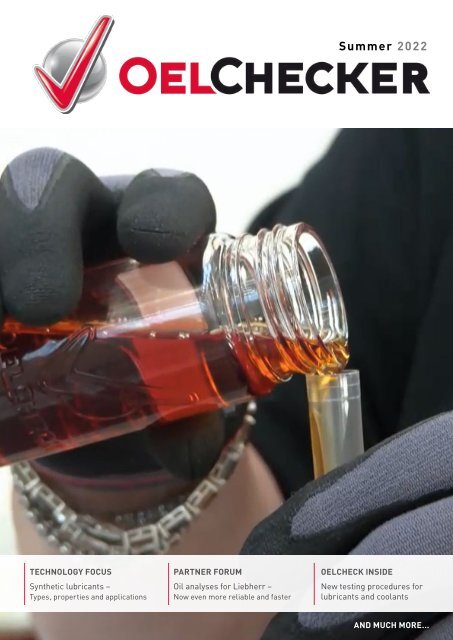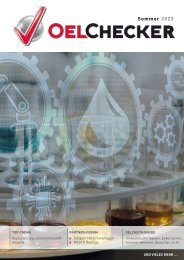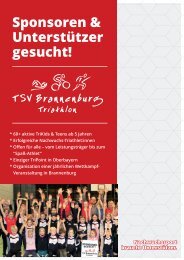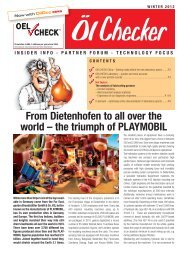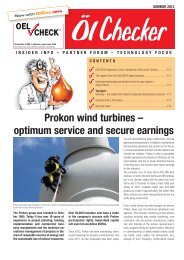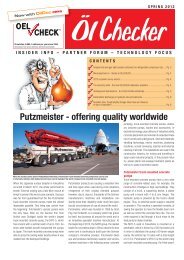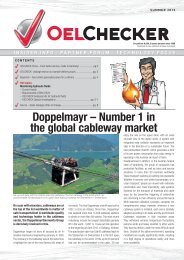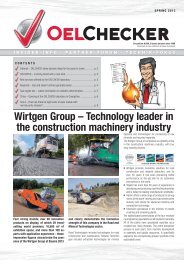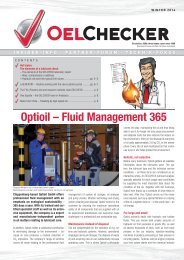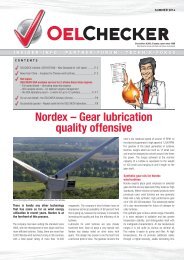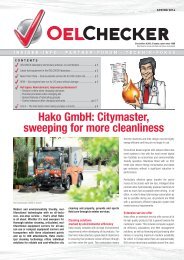OELCHECKER Summer 2022
You also want an ePaper? Increase the reach of your titles
YUMPU automatically turns print PDFs into web optimized ePapers that Google loves.
<strong>Summer</strong> <strong>2022</strong><br />
TECHNOLOGY FOCUS<br />
Synthetic lubricants –<br />
Types, properties and applications<br />
PARTNER FORUM<br />
Oil analyses for Liebherr –<br />
Now even more reliable and faster<br />
OELCHECK INSIDE<br />
New testing procedures for<br />
lubricants and coolants<br />
AND MUCH MORE...<br />
1
“<br />
CHECK-UP<br />
OELCHECK loves bees! Making honey is no easy task. Climate change and the large<br />
number of enclosed spaces are making life increasingly difficult for the army of bees in<br />
our mountainous region.<br />
So, we decided to transform one of our company's car parks into a large, unused space.<br />
And we didn't just concrete over it, either, as we transformed it into a bright, flowering<br />
meadow – a paradise for our new tenants, a colony of honey bees.<br />
Preparations for a beehive are already under way. Our beehive is currently being painted<br />
with organic-certified, coloured wood varnish by children from the Brannenburg<br />
children's nursery, and we can't wait to see what it looks like! Once it's finished, it will<br />
be placed in the middle of the flowering meadow.<br />
Adobe Stock – Darios<br />
The bee colony has been given to us by amateur beekeeper Michel Linnerer. As he runs<br />
OELCHECK's IT department for his day job, the beehive will also feature state-of-theart<br />
sensor equipment – Beehive 4.0. We'll then be able to use the OELCHECK website to<br />
view real-time data, such as the colony's weight, the temperature and humidity inside<br />
the hive, the number of bees coming and going, and the colony's health and mood.<br />
Alongside this extensive, modern technology, we've also incorporated a traditional<br />
show window, where interested observers can open doors and take a look inside the<br />
beehive through a glass pane.<br />
The OELCHECK bees will be looked after by Michael Linnerer and some of his colleagues,<br />
who are also experienced amateur beekeepers in their own right. Any honey<br />
harvested will be processed in Germany pursuant to the strict hygienic requirements<br />
of the German Honey Directive (HonigV). The OELCHECK honey produced will then be<br />
used in the company's canteen. The bees still have lots of work ahead of them before it<br />
gets to that stage, however. After all, they have to pollinate eight million flowers for just<br />
half a kilogram of honey!<br />
The busy bee colony is sure to be visited by the children from the Brannenburg children's<br />
nursery, with excursions to see our bees already firmly in the diary. Maya the<br />
Bee will also be showing and explaining to the little ones how bees live and make honey.<br />
This will make taking a peek into the show hive through the safety glass and finding the<br />
queen bee all the more interesting!<br />
Children will have loads of fun during their visits and learn about one aspect of a sustainable<br />
lifestyle at the same time.<br />
Paul Weismann Barbara Weismann<br />
“<br />
CONTENTS<br />
■ OELCHECK PARTNER FORUM<br />
Oil analyses for Liebherr – Now even more reliable and safer ......................................... 3<br />
Trans-Auto AB – Our exclusive agent in Sweden.................................................................12<br />
■ OELCHECK INSIDE<br />
New! NMR magnetic resonance imaging for lubricants ..................................................... 5<br />
Analogue and digital sample information forms.................................................................. 6<br />
How OELCHECK determines the flashpoint.......................................................................... 7<br />
Upgrade for coolant analyses...............................................................................................11<br />
■ TECHNOLOGY FOCUS<br />
Synthetic lubricants – Types, properties and applications................................................. 9<br />
■ Q&A<br />
Safety data sheets – Packaging leaflets to enhance safety ............................................. 13<br />
■ THE LATEST ON OILDOC<br />
Live in 2023, the OilDoc Conference & Exhibition ..............................................................14<br />
Seminar highlights in the autumn........................................................................................15<br />
Published by:<br />
OELCHECK GmbH<br />
Kerschelweg 28 · 83098 Brannenburg · Germany<br />
info@oelcheck.de · www.oelcheck.de<br />
Concept and text:<br />
OELCHECK GmbH · Astrid Hackländer<br />
Typesetting and design:<br />
Agentur Segel Setzen, Petra Bots, www.segel-setzen.com<br />
Image rights:<br />
OELCHECK GmbH · Liebherr GmbH · Trans-Auto AB ·<br />
OilDoc GmbH · Adobe Stock<br />
© <strong>2022</strong> OELCHECK GmbH<br />
All rights reserved. Reproduction only upon approval!<br />
2
PARTNER FORUM<br />
OIL ANALYSES FOR LIEBHERR EARTHMOVING<br />
AND MATERIALS HANDLING EQUIPMENT<br />
NOW EVEN MORE RELIABLE AND SAFER<br />
© Liebherr<br />
The name Liebherr has resonated with a wide range of high-quality<br />
products and services for over 70 years. The earthmoving equipment<br />
product segment comprises a broad portfolio of high-performance<br />
and high-quality products. This range includes mobile<br />
and crawler excavators, bulldozers and tracked loaders as well<br />
as pipe layers, telescopic handlers, wheel loaders and articulated<br />
dump trucks. In addition to mobile, crawler and electric material<br />
handling machines, the material handling equipment product segment<br />
also counts wheel loaders, telescopic handlers, bulldozers<br />
and wheel loaders among its extensive portfolio.<br />
The technology and design of earthmoving and material handling<br />
equipment are based on the practical requirements gleaned from<br />
use worldwide. In so doing, Liebherr sets a high bar when it comes<br />
to the quality of its products. That's why components in Liebherr's<br />
mechanical, hydraulic and electrical drive and control systems<br />
are largely developed and manufactured in-house. In addition, the<br />
company also offers an extensive range of selected lubricants and<br />
operating fluids that are specially optimised for use in Liebherr<br />
machines and are constantly in development based on feedback<br />
received in practice. To enable operators to get the most out of<br />
Liebherr equipment, such as a long service life and optimal protection<br />
against corrosion and wear and tear, Liebherr recommends<br />
OELCHECK's all-inclusive analyses as the perfect companion when<br />
using their machines. Liebherr and OELCHECK then tailor the results<br />
of the analyses to the individual Liebherr machine components<br />
and lubricants.<br />
OELCHECK analyses in the Liebherr range<br />
The partnership between Liebherr and OELCHECK began back in the<br />
early 1990s, when Liebherr recognised the potential of OELCHECK<br />
lubricant analyses for optimising machine maintenance. As a result,<br />
Liebherr became OELCHECK's first major customer in the construction<br />
machine industry.<br />
The all-inclusive analysis kits coming out of Brannenburg have<br />
since become an integral part of Liebherr's services over the years.<br />
Almost all of the analysis kits are tailored specifically to the company's<br />
machines and lubricants when it comes to scope and information<br />
content. The adapted sample information forms also speed<br />
up the time required to enter information, make it easier to dive into<br />
the detail for components and help contribute to the high quality of<br />
the sample assessment.<br />
Limit values are essential in analytics<br />
A laboratory analysis provides a whole host of values. However, to<br />
be able to assess these values in their entirety, you not only need<br />
experience, but also the following data so you can compare the values<br />
achieved:<br />
■ The reference values of the corresponding clean oil or clean lubricant<br />
■ Knowledge of how the product used has developed over time (if<br />
possible)<br />
■ Limit values for wear and tear, impurities and any degradation<br />
of additives<br />
Establishing these limit values is one of the greatest challenges for<br />
any lubricant analysis. Although component and machine manufacturers,<br />
lubricant suppliers or associations may sometimes provide<br />
limit values and recommendations, such values often stand alone,<br />
are isolated from each other and only take part of the picture into<br />
account. Yet which values for a used lubricant are considered too<br />
high or unexpectedly low? Up to which point is a value still within<br />
tolerance levels for some time, and when will it become critical?<br />
Moreover, what influence do a machine or component's operating<br />
conditions have on the limit value?<br />
OELCHECK uses limit values based on results from thousands upon<br />
thousands of analyses to assess the results returned by the oil analyses<br />
in practice. Also included in the definition of the company's own<br />
limit values are the specifications stipulated by the OEMs, institutions<br />
and lubricant manufacturers, which in any case must be taken<br />
into account for warranty conditions.<br />
Limit values for Liebherr – Individual and precise<br />
OELCHECK's database holds millions of datasets from a wide range<br />
of machines, lubricants and applications, and this number is growing<br />
on a daily basis. However, the limit values for Liebherr lubricants<br />
and operating fluids from the leading OEM's earthmoving<br />
and material handling machines hold a unique position. Liebherr<br />
and OELCHECK have worked closely together over the last decade<br />
to determine the corresponding limit values for these individual<br />
products. This allowed values to be generated with the maximum<br />
practical relevance thanks to differentiating between the individual<br />
machine series and the range of applications. These values are<br />
then statistically recorded, constantly validated and compared with<br />
repeated analyses of the individual components by Liebherr.<br />
3
PARTNER FORUM<br />
These individual limit values consider almost all aspects and further<br />
increase the accuracy of the analysis assessment. Since being<br />
selective with individual values inevitably leads to significant misjudgements,<br />
Liebherr and OELCHECK generally assess the interaction<br />
between the analysis values. This requires detailed knowledge<br />
of the lubricants and operating fluids used, the components, machines,<br />
their operating conditions and, of course, analytics.<br />
As such, there are now individual limit values for the use of Liebherr<br />
lubricants and operating fluids in a wide range of components from<br />
almost all of the OEM's earthmoving and material handling machines.<br />
Operators benefit from these limit values in several ways:<br />
Liebherr recommends the oil be changed every 6,000 operating<br />
hours. In practice, however, such hydraulic fluids can also<br />
reach a life cycle of up to 10,000 operating hours. OELCHECK's<br />
oil analyses ensure the necessary operational safety. Finally,<br />
they also use the limit values individually agreed with Liebherr<br />
for the degradation of additives, any wear particles and<br />
foreign substances in the lubricant. While the examination of<br />
hydraulic fluid often focuses primarily on extended oil change<br />
intervals, for other components it's all about checking the oil<br />
quality, checking for signs of potential contamination as well as<br />
the individual state of wear and tear or detecting damage early.<br />
■<br />
■<br />
High-precision diagnostics for Liebherr lubricants and components<br />
Thanks to the agreed limit values, Liebherr customers can receive<br />
detailed, tailored laboratory reports. As an example, individual<br />
limits are available for all key components for a single<br />
material handler. Whether it's the diesel engine, the hydraulics,<br />
the drive mode, the axles, the swivel gear or the derrick, its use<br />
is considered on an individual level when assessing a lubricant.<br />
Safety during condition-dependent oil changes<br />
Hydraulic fluids, for example, are changed with increasing frequency<br />
depending on their condition. As a rule, Liebherr Hydraulic<br />
HVI multi-grade hydraulic oil is changed after 3,000<br />
operating hours. If, however, the oil is subject to oil analyses,<br />
The analysis of Liebherr operating fluids results in benefits in<br />
several areas: on the one hand, any extension to the service life<br />
of hydraulic oil is better for the environment and resources, while<br />
on the other, detailed monitoring of the lubricant ensures the reliable<br />
and safe operation of earthmoving and material handling<br />
equipment at all times due to the best possible maintenance conditions<br />
and optimised operating costs.<br />
Liebherr – A family-owned company that sets standards<br />
The Liebherr Group is a family-run technology company offering a<br />
broad range of products. The company is one of the largest manufacturers<br />
of construction machinery worldwide, while also offering<br />
high-quality and practical products and services in many other<br />
areas. Today, the Group boasts more than 140 companies across<br />
all continents. In 2021, the Group had over 49,000 employees<br />
and generated consolidated sales totalling over €11.6 billion. Liebherr<br />
was founded in 1949 in Kirchdorf an der Iller, Germany. Since<br />
then, its staff have been striving to provide customers with sophisticated<br />
solutions and play a part in technological advancements.<br />
See www.liebherr.com for further information.<br />
NEW OELCHECK PRODUCT CATALOGUE<br />
DOWNLOAD NOW<br />
Our latest product catalogue is out now! Compact, clear and practical,<br />
it introduces you to our wide range of products, offers information<br />
about the respective test configurations of our all-inclusive<br />
analysis kits, and helps you select the right kit for your needs. It also<br />
gives you an overview of the products from our accessories shop as<br />
well as any additional tests, and explains all the benefits offered by<br />
the OELCHECK system.<br />
www.oelcheck.de/produktkatalog<br />
4
OELCHECK IS A PIONEER<br />
INSIDE OELCHECK<br />
NMR USED FOR THE FIRST TIME IN COMMERCIAL LUBRI-<br />
CANT ANALYSES<br />
Magnetic resonance imaging (MRI), also known as nuclear magnetic resonance (NMR), is primarily<br />
used in the medical industry, and is likely the most powerful analysis tool of all in organic chemistry.<br />
Now, it can also be used for lubricant analyses for the first time, with OELCHECK having developed<br />
the foundations for doing so together with the Karlsruhe Institute of Technology (KIT). OELCHECK<br />
now offers the concentration of active, phosphorus-based, anti-wear additives in oils to be determined<br />
using phosphorus NMR as an additional test. This provides even greater certainty when deciding<br />
whether an oil needs to be changed or not, particularly when topping up using an oil boasting<br />
long operating cycles.<br />
Throughout an oil's life cycle, its additives change – and the additives'<br />
structure correlates with their effect. Oil analyses can offer<br />
conclusions about the operational readiness of these active ingredients.<br />
Anti-wear (AW) and extreme pressure (EP) additives are particularly<br />
interesting, as they have to protect the lubricated components<br />
of the respective application within the tolerated limits. These<br />
additives are typically based on compounds containing phosphorus,<br />
which change over the oil's life cycle.<br />
In the first instance, this concerns the additive content, which is traditionally<br />
determined in a lab using ICP-OES (inductively coupled<br />
plasma atomic emission spectroscopy). With the new phosphorus<br />
NMR, we can now also monitor the molecules of these phosphorus-based<br />
active ingredients in detail and identify any changes over<br />
an oil's service life. In particular, the phosphorus core is excited in<br />
a magnetic field and resonated via a radio frequency. These resonances<br />
depend on the molecule's structure and therefore provide<br />
what is known as a specific 'chemical shift'.<br />
The assessment of the results always requires a comparison with<br />
the corresponding clean oil. This is then analysed and its additive<br />
components containing phosphorus are determined using the phosphorus<br />
NMR. The used oil samples are compared to the reference to<br />
determine any percentage decrease in the active phosphorus-containing<br />
AW and EP additives.<br />
The phosphorus NMR therefore provides valuable additional information<br />
on traditional oil analyses. If any changes in the additive<br />
content are detected and the phosphorus NMR also shows significantly<br />
reduced – or even no – active AW or EP additives, that's a<br />
clear indication that the oil has been used to its capacity. In that<br />
case, the oil must generally be changed. However, the fall in the level<br />
of the active additive after an oil change is not, in itself, a reason<br />
to change the oil. Additives are designed to cover metal surfaces,<br />
which means it's normal for the additive content to drop after the oil<br />
has been changed.<br />
The additional NMR test is highly suited to large quantities of oil with<br />
long life cycles. The additional information provided on the condition<br />
of the additives offers greater certainty when deliberating whether<br />
the oil needs to be changed. Yet the new process also proves its worth<br />
in a range of other instances. Among other things, it can be used in<br />
damage assessments and development projects, such as testing<br />
engines. OELCHECK can then determine the fall in anti-wear additives<br />
with the phosphorus NMR alongside a traditional oil analysis.<br />
Dr Christoph Rohbogner<br />
Head of Tribology<br />
BRANNENBURG SKATE PARK GIVEN A NEW LEASE OF LIFE<br />
This was the day the skaters had been waiting for. The renovated<br />
Brannenburg skate park reopened in May <strong>2022</strong>, and the skaters<br />
couldn't wait to try it out. In addition to a new ramp, the skate park<br />
now features starts, additional obstacles and two rails. OELCHECK<br />
supported the skate park's modernisation and expansion by donating<br />
€5,300 to the cause, and it was finally time for the skaters to get<br />
back up to speed. The young people and youth representatives who<br />
came up with the initiative for the project are delighted with the new<br />
skate park.<br />
THANK YOU, OELCHECK!<br />
Present at the skate park's reopening: Matthias Jokisch (Mayor of the Municipality<br />
of Brannenburg), Paul Weismann (Managing Director, OELCHECK GmbH) and Stefanie<br />
Mikesch (Youth Representative at the Municipality of Brannenburg)<br />
OELCHECK BUSINESS BIKES<br />
It's time to get back in the saddle as the first OELCHECK Business<br />
Bikes have arrived. Wolfgang Beilhack, Diana Zaisserer and Benjamin<br />
Ludwig (from left to right) are the first members of staff to use<br />
them to get around, using the new bikes for their commute to work or<br />
private journeys instead of taking the car or public transport as much<br />
as they can. The OELCHECK Business Bikes allow us to promote an<br />
alternative form of mobility and encourage our employees to improve<br />
their health. And last but not least, together we're helping to reduce<br />
our carbon footprint!<br />
5
SAMPLE INFORMATION FORMS<br />
THE MORE PRECISE THE INFORMATION, THE<br />
MORE PRECISE THE DIAGNOSIS!<br />
OELCHECK has been the leading laboratory for lubricant and operating<br />
fluid analyses in Europe and beyond for more than thirty years.<br />
By combining our experience and findings from years of work and<br />
state-of-the-art analytical methods, we produce clear analyses and<br />
recommendations for our customers.<br />
And the more precise the sample information submitted, the more<br />
precisely the diagnosis and recommendation can be tailored to the<br />
specific application.<br />
Tailor-made analyses<br />
The machine type, operating fluid used, and ambient conditions –<br />
OELCHECK tribologists consider swathes of additional information<br />
when interpreting lab results. However, our tribologists can only<br />
consider all aspects when taken together as a whole and make tailor-made<br />
recommendations in the laboratory report if complete, accurate<br />
sample information is provided.<br />
DIGITAL IS IDEAL!<br />
Special information for special applications<br />
A range of information is crucial depending on the application and<br />
machine type. At OELCHECK, you can provide relevant information<br />
for the intended use. You can receive a step-by-step guide for the data<br />
fields on our LAB.REPORT customer portal or the OELCHECK 4.0 app,<br />
with both tools also asking for additional information specific to the<br />
application.<br />
Fully prepared for your applications<br />
Included in all standard OELCHECK all-inclusive analysis kits, the<br />
universal sample information form can be used for any operating fluid<br />
and any machine. Whether you're using grease, coolant or gearbox<br />
oil, the universal form will have the correct fields. For more detailed<br />
information, please refer to our application-specific sample information<br />
forms.<br />
Universal sample information forms now even clearer<br />
■ Sample information forms should be clear and understandable,<br />
with four distinct areas for logging information on the sample,<br />
the machine, the components and the customer. A detachable<br />
document field serves as a reference for the sample sent in.<br />
Amendments to any designations mean there is a consistent<br />
process from paper to digital, with the same terms always having<br />
the same meanings.<br />
■ Our universal sample information form has all bases covered –<br />
'oil' is therefore too short and is replaced by 'fuel'.<br />
■ Each field has a unique heading, with the corresponding fields<br />
to be filled in featured below. Making assumptions are a thing of<br />
the past.<br />
■ If a follow-up inspection is involved, the machine and component<br />
will already have been created in our system. The corresponding<br />
information on the sample information form can therefore be<br />
omitted. The 'Previous laboratory number' field will therefore be<br />
relocated to the centre of the sample information form for machine<br />
data.<br />
Anton Kathrein<br />
Head of Global Sales<br />
OUR SAMPLE INFORMATION FORMS<br />
In addition to the universal sample information form, which can be used for every type of lubricant and every machine, OELCHECK offers<br />
further special sample information forms. These are adapted to the respective lubricant application and can record special data. The<br />
special sample information forms listed below are currently available:<br />
Gas engines<br />
Transmissions<br />
Hydraulics<br />
Refrigeration<br />
compressors<br />
Fuels<br />
Wind turbines<br />
Power stations<br />
and turbines<br />
Coolant and<br />
anti-freeze agents<br />
Engines<br />
Lubricating<br />
grease<br />
Compressors<br />
Paper<br />
machines<br />
6
INSIDE OELCHECK<br />
AWARE OF THE ENVIRONMENT AND EXTREMELY PRECISE<br />
HOW OELCHECK DETERMINES THE FLASHPOINT<br />
The flashpoint is the key criterion for the flammability of combustible<br />
liquids. Combustible liquids includes fuels such as kerosene, conventional<br />
diesel fuel and biodiesel, whose classification into hazard<br />
classes is based on their flashpoint and more. However, the flashpoint<br />
also provides valuable assistance when inspecting engine oils<br />
and heat transfer media. If significantly lower, it may indicate that engine<br />
oil has mixed with a fuel or, in the case of heat transfer media, the<br />
formation of volatile cracked products and the associated increased<br />
risk of fire.<br />
Although the procedure is rather complex, determining the flashpoint<br />
using a small, closed crucible has several advantages:<br />
■ Volatile components in the sample do not go unnoticed. Our employees<br />
and the environment are protected from any harmful<br />
emissions.<br />
■ Only a small sample amount (30ml) is required.<br />
■ Each sample specimen is only tested once.<br />
■ The examination process is partially automated and therefore<br />
streamlined.<br />
The flashpoint is defined as the lowest temperature at which a vapour<br />
phase formed over a liquid can be ignited with a test flame or electric<br />
igniter. Yet the sample itself doesn't burn – only the vapour phase<br />
does, and the flame then goes out again immediately.<br />
Determination with small, closed crucibles<br />
Determining the flashpoint is included in some OELCHECK all-inclusive<br />
analysis kits as standard. Setaflash flashpoint test devices with<br />
a small, closed crucible for a flashpoint<br />
in the range of 30-300°C are<br />
installed in our lab for this purpose.<br />
Ignition test in a Setaflash<br />
flashpoint tester<br />
We therefore determine the flashpoint<br />
pursuant to DIN EN ISO 3679,<br />
ASTM D3828 or ASTM D7236 in<br />
several incremental steps, which<br />
are then repeated to make sure we find the<br />
exact flashpoint. First, a sample quantity of<br />
2ml (below 100°C) or 4ml (above 100°C) is placed into the crucible and<br />
tempered to the expected flashpoint temperature for 60 or 120 seconds.<br />
The tester's ignition device is then triggered. If a vapour phase<br />
has not formed at the temperature and cannot be ignited, the crucible<br />
is filled with a new sample quantity and tempered at a new test temperature.<br />
The next ignition attempt then follows, with this process<br />
repeated using clean sample quantities and different temperatures<br />
until the flashpoint is established.<br />
Determination using the Cleveland<br />
method with an open crucible<br />
Preparation for determination using<br />
the Pensky-Martens method<br />
Alternative methods as additional tests<br />
In addition to the small, closed crucible method, we determine the<br />
flashpoint using the Cleveland open crucible method (DIN EN ISO<br />
2592, ASTM D92 / application of 79-400°C) and the Pensky-Martens<br />
closed crucible method (DIN EN ISO 2719, ASTM D93 / application<br />
of 40-370°C).<br />
These are offered as additional tests to the all-in-one analysis kits.<br />
However, the following must be considered:<br />
■ In the Cleveland method, the crucible is open. And according to the<br />
Pensky-Martens method, the larger, closed crucible must also be<br />
open for testing, too. In this process, parts of volatile components<br />
can escape without a flashpoint being detected.<br />
■ This means a minor ingress of fuel into an engine oil or an incipient<br />
accumulation of cracked products in heat transfer oils can<br />
quickly be overlooked.<br />
■ A sample volume of 200ml is therefore required during these<br />
test procedures, while a sample volume of 30ml is enough to<br />
determine the flashpoint with a small, closed crucible.<br />
Dr Thomas Fischer<br />
Scientific Director<br />
Dr Raphael Grötsch<br />
Scientific Team Assistant<br />
MEET THE TEAM!<br />
20-23/09/<strong>2022</strong> | Berlin<br />
27-30/09/<strong>2022</strong> | Hamburg 24-30/10/<strong>2022</strong> | Munich<br />
15-18/11/<strong>2022</strong> | Hannover 9-11/05/2023 | Rosenheim<br />
Feel free to arrange an appointment with<br />
your OELCHECK contact person in advance by<br />
emailing<br />
sales@oelcheck.com!<br />
7
INSIDE OELCHECK<br />
COOLANT<br />
UPGRADE FOR THE PREMIUM ALL-INCLUSIVE ANALYSIS KIT<br />
Since July <strong>2022</strong>, the Premium all-inclusive analysis kit for coolants<br />
and anti-freeze agents has included the HPLC-MS test. This has replaced<br />
the HPLC test and is included in the price to date. Using the<br />
HPLC-MS test, we can detect the degradation of additives, such as<br />
corrosion inhibitors, and any mixtures with even greater precision.<br />
To aid the extended scope of testing, we have installed a new mass<br />
spectrometer (MS) in the lab and combined it with an existing<br />
high-performance liquid chromatograph (HPLC). Before now, this<br />
device had 'only' been equipped with a UV/Vis detector that uses the<br />
electromagnetic waves of ultraviolet (UV) and visible light (Vis). The<br />
coolant samples are then separated into their constituents on the<br />
chromatographic column, and the individual components are then<br />
analysed qualitatively and quantitatively using both UV absorption<br />
and mass spectrometers. The values specified are listed in the lab<br />
report in mg/l.<br />
Connecting the mass spectrometer to the existing process enables<br />
measurements to be recorded with even greater precision. In addition,<br />
the HPLC-MS also expands the portfolio of components to be<br />
determined. This allows us to detect any mixtures more effectively<br />
and, above all, to detect an even larger number of additives, which<br />
are mainly used as corrosion inhibitors in the form of organic acids.<br />
Coolants – Triple inspection<br />
Coolants ensure optimum heat supply and extraction, protect<br />
against corrosion, cavitation and deposits, and prevent freezing at<br />
sub-zero temperatures. Like lubricants, the properties of aqueous<br />
coolants also change due to soiling and ageing. As they age, ethylene<br />
glycol degradation products act as acids in coolants. At the<br />
same time, the amount of organic acids added to coolants as corrosion<br />
inhibitors falls.<br />
To date, we have already determined the following values as part of<br />
each coolant analysis:<br />
■ Classic glycol degradation products (acetate, formate, glycolate<br />
and oxalate) using ion chromatography (IC)<br />
■ The content of corrosion inhibitors or organic acids, such as<br />
azo compounds (benzotriazole, tolyltriazole, mercaptobenzothiazole)<br />
and aromatic carboxylic acids (benzoic acid, toluic acid)<br />
using an UV detector<br />
The new MS detector allows us to determine additional substances<br />
also contained in some coolant agents and corrosion inhibitors:<br />
Î Nonanoic acid, decanoic acid, dodecanoic acid, pimelic acid, octanedoic<br />
acid and dodecanoic acid.<br />
If an additional corrosion inhibitor is present in the sample, it is<br />
indicated on the lab report.<br />
HPLC-MS opens up new perspectives when it comes to investigating<br />
coolants and anti-freezes. The Premium all-in-one analysis kit<br />
for coolants and anti-freeze includes the determination of further<br />
corrosion inhibitors. Yet the new HPLC-MS offers many more possibilities<br />
– and preparing to investigate additional additives is just<br />
one example.<br />
Dr Christoph Heinzl<br />
Scientific Team Assistant<br />
RESEARCH PROJECTS AND STANDARDISATION GROUPS<br />
OELCHECK is active on national and international research projects<br />
and in standardisation groups. We are currently actively involved in<br />
the following projects:<br />
■ ipH value – Ring trial<br />
The Technical Committee for Mineral Oil and Fuel Standardisation<br />
(FAM) is the DIN (Deutsches Institut für Normung e.V.)<br />
committee responsible for all standards relating to oils and fuels.<br />
FAM is responsible for more than 600 standards (DIN, DIN<br />
EN, DIN EN ISO, DIN ISO and ISO). Dr Thomas Fischer, Scientific<br />
Director at OELCHECK GmbH, is responsible for all titration<br />
methods in the used oil working group at DIN.<br />
■<br />
Every year, the Technical Committee conducts the 'large-scale<br />
FAM ring trial' in the areas of fuels and lubricants. In spring<br />
<strong>2022</strong>, OELCHECK organised a ring comparison in the working<br />
group to determine the ipH value in accordance with ASTM<br />
D7946. This comparison serves to ensure the quality of the<br />
measurement procedure and the testing labs involved. To this<br />
end, OELCHECK has compiled five representative samples over<br />
the method's entire area of application, filled them and sent<br />
them to all participating laboratories. The final assessment of<br />
the ring trial results will be carried out by FAM.<br />
Fluids for e-mobiles – Corrosion effect on copper<br />
A modified test for testing the corrosive effect of e-fluids on<br />
copper is currently being examined by the Technical Committee<br />
for Mineral Oil and Fuel Standardisation in a comparative<br />
study. As OELCHECK is also involved in the standardisation of<br />
new, specific test procedures, we are actively taking part in this<br />
study.<br />
8
TECHNOLOGY FOCUS<br />
THE WIDE RANGE OF<br />
'SYNTHETIC LUBRICANTS'<br />
TYPES, PROPERTIES AND APPLICATIONS<br />
If the lubrication of a component or machine is to be optimised or the oil changed far less often, synthetic-based<br />
products are often the method of choice. Their synthetic base oils are created 'artificially'<br />
using chemical processes, while their molecules are tailor-made to measure and usually highly<br />
robust. This usually results in the oil having a longer service life and a higher viscosity index, which<br />
enables friction-reducing, thinner oils to be used. When combined with organometallic additives,<br />
these properties improve the energy efficiency of engines, hydraulic systems and transmissions,<br />
enable their more sustainable use and therefore contribute to reducing CO 2<br />
emissions.<br />
'Synthetic lubricants' combine a whole host of lubricants, although they differ in their composition<br />
and properties. However, they aren't always compatible – or can't always be mixed – with other<br />
synthetic lubricants or mineral base oils.<br />
Like their mineral counterparts, synthetic lubricants aren't manufactured<br />
based on crude oil, but on natural gas derivatives or other<br />
raw materials. Polyalphaolefins (PAO), which rank among the most<br />
common synthetic base oils, are made from ethylene and unsaturated<br />
hydrocarbons, for example. These hydrocarbons are mainly<br />
extracted from natural gas, and their molecules are converted<br />
using a chemical process (polymerisation) under the influence of<br />
catalysts. The hydrocarbons' low-viscosity, low-molecular-weight<br />
compounds (monomers) are linked to lubricating macromolecules<br />
(polymers) through chain growth reactions.<br />
Unlike mineral oils, where a single batch of oil can contain millions<br />
of different molecular structures, the molecular sizes and shapes<br />
present in a synthetic oil are far more homogeneous. In addition, the<br />
chemically converted molecules show significantly higher levels of<br />
consistency, proving far more resistant and able to better withstand<br />
the harsh operating conditions without oxidising or thermally decomposing.<br />
This results in one of the largest benefits of synthetic<br />
lubricants: they can be used for far longer than mineral lubricants<br />
(even at elevated operating temperatures), which contributes to engines<br />
and machines being run sustainably.<br />
A further benefit of synthetic base oils is their higher viscosity index<br />
(VI). This is calculated using the viscosities measured at 40°C and<br />
100°C. The higher the viscosity index of an oil, the lower its viscosity<br />
changes with the temperature. Due to their good viscosity temperature<br />
behaviour, synthetic lubricants can often be selected for certain<br />
applications requiring a lower viscosity than mineral lubricants.<br />
This minimises the inevitable splash and friction losses during lubrication,<br />
which in turn opens up huge potential for energy savings.<br />
The low-viscosity, synthetic-based, premium engine oils we see today<br />
are likely the best-known example of how synthetic lubricants<br />
can reduce friction and increase energy efficiency at the same time.<br />
Whereas in the past, multigrade engine oils previously had a viscosity<br />
of mostly SAE 20W-50, today it's often SAE 0W-20 and below. Low<br />
viscosity synthetic oils allow engines to run increasingly smoothly<br />
and consume less fuel.<br />
This principle also suggests that the operation of hydraulics, bearings<br />
and gears can also benefit from synthetic lubricants if, for example,<br />
a synthetic hydraulic oil HLP 32 is used instead of a mineral<br />
HLP 46, or a synthetic CLP 220 is used instead of a mineral CLP 320<br />
for gear oils.<br />
Thin oils also transfer heat better, which offers a few key advantages:<br />
The reduction in friction, which is further heightened with<br />
new, organometallic additives, means the temperature at the friction<br />
point and the amount of oil needed to fill the system falls. Tank<br />
volumes may be reduced during the design phase, thanks to the oil<br />
being under less thermal stress and oxidation and oil ageing slowing<br />
down. The oil also remains usable for longer.<br />
The lubricated component surfaces are smoother due to the influence<br />
of additives. A stable lubricating film that prevents abrasive<br />
wear forms more easily. This leads to components being less susceptible<br />
to requiring repair and their downtime being reduced.<br />
Î<br />
Low-viscosity synthetic lubricants can reduce energy losses in<br />
such a way that energy-consuming production facilities need<br />
less energy in operation or energy-generating facilities produce<br />
greater amounts of electricity.<br />
Overall, lubricants based on synthetic base oils enable a greater<br />
sustainable use of lubricants as well as the components supplied by<br />
them, which all contributes to reducing CO 2<br />
emissions.<br />
9
MINERAL OR SYNTHETIC – AN OVERVIEW OF BASE OILS<br />
The base oils form the foundation of all lubricants and more than 75% of the main components. Depending on the area of application, these<br />
are supplemented with additives or active ingredients. These base oils must undergo a range of processing steps and differ both in terms<br />
of performance and price level. Base oils are divided into conventional mineral oils (Groups I to III) extracted from crude oil by refining, and<br />
synthetic oils (Groups IV and V) arising from chemical processes.<br />
Group Description Price<br />
Factor<br />
I<br />
II<br />
III<br />
Solvent raffinates, from conventional<br />
refining<br />
Raffinates from catalytic deparaffination,<br />
low in aromatics<br />
Semi-synthetic, hydrocracked raffinates,<br />
aromatic-/sulphur-free<br />
Operating<br />
Range<br />
[°C]*<br />
Density<br />
20°C<br />
[g/ml]*<br />
Viscosity<br />
Index (VI)*<br />
1 -20 – 100 0.8 – 0.9 75 – 100<br />
1.5 – 2 -25 – 110 0.8 – 0.9 85 – 115<br />
2 – 3 -30 – 120 0.8 – 0.9 110 – 135<br />
IV PAO-based synthetic oils 2 – 5 -30 – 140 0.8 – 0.9 135 – 160<br />
Vegetable oils (HETG) 3 – 4 -10 – 80 0.8 – 0.9 180 – 200<br />
V Synthetic esters 3 – 6 -30 – 170 0.9 – 1.0 140 – 190<br />
Glycols (polyalkylene) PAG 3 – 5 -30 – 200 1.0 – 1.2 200 – 240<br />
Silicones 50 – 100 -50 – 250 0.9 – 1.1 200 – 350<br />
Perfluoropolyethers (PFPE) 100 – 400 -40 – 290 1.8 – 2.0 110 – 150<br />
Î<br />
Î<br />
Compatibility / Miscibility<br />
Pay careful attention when changing oil types<br />
or using flushing oils. Even residual quantities<br />
of oils of the same base, but with different<br />
additives, can impair the air and water separation<br />
behaviour and more<br />
Glycol-, silicone- and PFPE-based oils can<br />
only be mixed and are only compatible with<br />
oils of the same base<br />
*) Figures are approximate values from the manufacturer's product information. These values may change depending on the viscosity, additives and the intended use.<br />
Groups I to III<br />
Group I mineral base oils are vacuum distillates of crude oil and<br />
are now only used for applications with low technical requirements.<br />
The base oils most commonly used today in Group II are low-aromatic<br />
and low-sulphur mineral oil raffinates. These are obtained under a<br />
hydrogen atmosphere by heat treatment, similar to Group I oils.<br />
Applications<br />
Polyalphaolefins are used in 95% of the production of fully synthetic<br />
engine, gear and compressor oils. In addition, HEPR (hydraulic oil<br />
environmental polyalphaolefins and related products) biodegradable<br />
hydraulic fluids, for example, are based on them, too. PAOs<br />
are also contained in some physiologically harmless lubricants<br />
(NSF-H1) for the food and pharmaceutical industries.<br />
10<br />
Group III comprises hydrocracked oils and strongly heat-treated,<br />
aromatic- and sulphur-free mineral oil raffinates. Hydrocracking is<br />
a catalytic cracking process in the presence of hydrogen at a temperature<br />
of 400°C and a pressure of 13-17 MPa. Hydrocarbon compounds<br />
are converted from gas oil or crude paraffin into long-chain<br />
molecules.<br />
Group III base oils are the mineral base oils that are subjected to<br />
the most intense refining process. Compared to Group I and II oils,<br />
they are characterised by a significantly higher viscosity index of<br />
up to 150, greater oxidation resistance and improved behaviour in<br />
cold temperatures. The end products produced using their basis are<br />
often labelled 'HC synthetic oil', 'Semi-synthetic' or even 'Synthetic'<br />
by their manufacturers. In Germany, however (and unlike in the<br />
USA), the term 'synthetic oil' may not be used for HC oils, but only<br />
for PAO and ester base oils.<br />
Group IV<br />
Polyalphaolefins (PAO)<br />
Polyalphaolefins are the most commonly used synthetic base oils.<br />
They are manufactured using an ethylene base, which is obtained<br />
from intermediary products from the process of refining petroleum<br />
and natural gas. As polyalphaolefins resemble mineral oils in their<br />
chemical structure, they are often also referred to as 'synthetic<br />
mineral oils' or 'synthetic hydrocarbons' (SHC).<br />
Properties<br />
■ Good viscosity temperature behaviour<br />
■ Increased natural oxidation and thermal stability<br />
■ Low evaporation tendency<br />
■ Miscible and compatible with almost all mineral and ester oils<br />
■ Behaviour similar to mineral base oils with regard to paints and<br />
seals<br />
Group V<br />
Base oil group V is assigned to all other base oils not covered by<br />
Groups I to IV. The main synthetic base oils in Group V include polyglycols<br />
(PAG), synthetic esters, silicone oils and perfluoropolyether<br />
(PFPE) oils.<br />
Polyglycols (PAG)<br />
Polyalkylene glycols, known as polyglycols (PAGs) for short, are polyvalent<br />
alcohols and therefore not oils in the conventional sense. Compared<br />
to mineral-based, PAO-based or ester-based oils and most additive<br />
types, PAG oils have a significantly higher density of 1.0-1.2g/cm³<br />
instead of around 0.9g/cm³. PAG-based oils cannot therefore be mixed<br />
with conventional oils, as they have a higher water solubility that does<br />
not settle and therefore cannot be removed. Some of these oils are<br />
even hygroscopic.<br />
Properties<br />
■ Very good viscosity temperature behaviour<br />
■ Wide temperature range; good high and low temperature<br />
properties<br />
■ Very high ageing and oxidation stability<br />
■ Very good high-pressure (EP) properties – even without additional<br />
additives<br />
■ Cannot be mixed with other oils<br />
■ Compatibility with seals (except EPDM), paints and varnishes<br />
■ Problems with aluminium at the lubrication point possible<br />
Applications<br />
As polyglycol oils have a high natural capacity to absorb pressure,<br />
they are primarily used for lubricating roller and slide bearings and<br />
worm gears. As high-temperature oils, they are used, among other
TECHNOLOGY FOCUS<br />
things, in compressor and hardening oils, in metal processing and<br />
heat transfer fluids, as well as in lubricants pursuant to NSF-H1 for<br />
the food industry.<br />
They also serve as the basis for flame-retardant hydraulic fluids as<br />
well as biodegradable HEPG (hydraulicoil environmental polyglycol)<br />
hydraulic fluids. However, since polyglycols quickly absorb water,<br />
the use of HEPG should be controlled. It is a different situation when<br />
they are used in brake fluids that are also manufactured using a<br />
PAG base (with the exception of type DOT 5).<br />
Synthetic esters<br />
Unlike natural esters, synthetic esters aren't based on vegetable oils<br />
or animal fats. Synthetic esters are built on carboxylic acids and alcohols,<br />
while natural esters are of a biogenic origin. They are mainly<br />
used as the basis for hydraulic oils of the type HETG (hydraulic oil<br />
environmental triglyceride), which are primarily used in agriculture,<br />
forestry and other environmentally sensitive areas. Although additives<br />
are also added to these products, their resistance to ageing is significantly<br />
lower than that of their synthetic counterparts. Synthetic esters<br />
can be 'tuned' to almost any desired structure and application, whether<br />
you want excellent oxidation stability, biodegradability, good lubricity,<br />
a higher viscosity index or good characteristics at low temperatures.<br />
Using the right synthetic ester means that most properties can be<br />
achieved with only a small number of additives required.<br />
Synthetic esters are inherently prone to hydrolysis, a water-induced<br />
chemical reaction that can lead to a rapid increase in the acid number<br />
combined with a loss of viscosity. The tendency towards hydrolysis<br />
can, however, be prevented by using chemicals in the ester production<br />
process, in the form of branched carboxylic acids.<br />
Properties<br />
■ Good long-term properties provide high ageing stability<br />
■ Tendency to hydrolysis; problematic in humid environments<br />
■ Can be mixed with mineral oils and polyalphaolefins (PAO)<br />
■ Ester-based paints may be dissolved<br />
■ Sealing materials tend to swell<br />
Applications<br />
Base oils based on synthetic esters are often used in refrigerator<br />
oils. They are also used for the production of high-temperature<br />
chain lubricants, low-viscosity metalworking oils, spindle oils and<br />
flame-retardant lubricants. Based on synthetic esters, the type<br />
HEES is currently the most commonly used biodegradable hydraulic<br />
oil. Synthetic esters can be combined with polyalphaolefins to<br />
improve the solubility of additives.<br />
Silicones<br />
Sharing a name with the element silicon and manufactured by<br />
chemical synthesis, silicone oils are polymerised siloxanes with<br />
organic side chains. Silicone oils can achieve an extremely high viscosity<br />
index and stand out due to their thermal and oxidative stability.<br />
However, these relatively expensive products are chemically inert,<br />
which means they do not react (or only react slightly) with potential<br />
reactive elements, such as metal surfaces. Additives with lubricating<br />
agents, which should remain in solution, are also problematic.<br />
The colourless silicone oils wet the surfaces with their creep<br />
properties, yet they cannot be removed by commercially available<br />
solvents. This means the test devices must be cleaned manually after<br />
undergoing testing in the laboratory. OELCHECK therefore only<br />
examines silicone oils using certain devices and samples must be<br />
marked with 'silicone oil'.<br />
Properties<br />
■ Wide operating temperature range<br />
■ Extremely fluid even at low temperatures<br />
■ Excellent oxidation stability, high thermal stability<br />
■ Cannot be mixed with other base oils<br />
■ An addition of a few milligrams or kilograms can change the<br />
surface tension as an anti-foam additive<br />
■ Due to their inert behaviour, silicone oils are compatible with<br />
paints, plastics, seals and other materials<br />
Applications<br />
Silicone oils are mainly used in their pure form in heat transfer oils<br />
and insulating liquids. They are almost exclusively used as lubricants<br />
for plastics, while they serve as release agents and as a base liquid<br />
for sealing silicone greases. They also form the basis for some<br />
NSF-H1 hydraulic oils for the pharmaceutical industry. As defoamers,<br />
they reduce foaming, particularly in lubricants presenting a high<br />
concentration of additives. Silicone oils are also the main component<br />
of brake fluids pursuant to DOT 5. Silicone oils offer a higher dry and<br />
wet boiling point of at least 260°C or 180°C and a lower viscosity.<br />
These properties give the brake fluid faster reaction times and a longer<br />
service life.<br />
Perfluoropolyether (PFPE) oils<br />
The high-priced perfluoropolyether oils are produced by polymerisation<br />
of fluorinated alcohols. The atomic bond from fluorine to carbon<br />
is one of the most stable chemical compounds in its own right.<br />
The non-flammable PFPE products are extremely inert, chemically<br />
and thermally stable and therefore resistant to aggressive media<br />
and ionising radiation, even at temperatures above 200°C.<br />
Properties<br />
■ High viscosity index enables high operating temperatures<br />
■ Absolute oxidative and thermal stability; highest across all base<br />
oil types<br />
■ No appreciable evaporation loss up to around 300°C<br />
■ PFPE oils cannot be mixed with any other base oil because of their<br />
density of around 2g/cm³<br />
■ The 'heavy' oils behave neutrally towards paints, plastics, seals<br />
and materials<br />
Applications<br />
Perfluoropolyether oils are used when conventional lubricants do<br />
not provide sufficient performance. This may be the case, for example,<br />
at lubrication points in radiation-intensive areas and in chemically<br />
aggressive environments. In vacuum pumps, such as those<br />
used in semiconductor manufacturing, aggressively corrosive gases<br />
destroy traditional pump oils after a short period of time. PFPE<br />
base oils can provide assistance here. Perfluoropolyether oils are<br />
also the lubricant of choice for lubrication points under oxygen overpressure<br />
(such as oxygen fittings) and for loss-of-chain lubrication<br />
at extremely high temperatures. As PTFE-thickened lubricating<br />
grease, they are suitable as sliding and roller bearing grease for hot<br />
air fans and for applications where lifetime lubrication is required,<br />
such as in the aerospace industry.<br />
Peter Weismann<br />
Technical Director (Advisory Board)<br />
11
PARTNER FORUM<br />
SWEDEN – TRANS-AUTO AB STARTS AS AN EX-<br />
CLUSIVE AGENT FOR OELCHECK<br />
When it comes to drive systems, industrial automation systems or equipment and lubricant management services in<br />
Scandinavia, Trans-Auto AB is right at the top of the list. Since 2021, the company has taken up the role of being the<br />
exclusive agent for OELCHECK in Sweden and Norway. The all-inclusive analysis kits from Germany are a perfect fit for<br />
the company's ambitious programme.<br />
Trans-Auto AB works with some of the world's leading manufacturers<br />
of drive components for commercial vehicles and ships. Hydraulic systems<br />
and components form part of their range, which also includes oil<br />
filters, oil sensors and test kits for use in the field.<br />
The experts at Trans-Auto AB are only too aware of the important<br />
role that sophisticated lubricant management plays in predictive<br />
maintenance. This made the decision to include lubricant analyses<br />
in the range an easy – and logical – one. After engaging in initial<br />
consultations with OELCHECK, it quickly became clear that getting<br />
oil analyses from the market leader was the best way forward if they<br />
were required. The OELCHECK system works – it's well thought-out,<br />
easy to use and offers users a wide range of additional services, such<br />
as the LAB.Report web portal and the mobile OELCHECK app. However,<br />
one fact was particularly crucial when opting for OELCHECK:<br />
not only do customers have access to the data results through<br />
the analyses from Germany, but OELCHECK tribologists also add<br />
well-founded comments to each individual lab report. Doing so<br />
gives customers reliable information they can use to help make other<br />
decisions further down the line. And because OELCHECK is an<br />
independent laboratory, free from being influenced by lubricant or<br />
machine manufacturers, the analyses are completely objective, too.<br />
A customer base with potential<br />
Founded in 1968, Trans-Auto AB focuses primarily on the B2B business.<br />
Mobile systems for the off-highway sector are at its core, and<br />
such systems include facilities and components for the construction<br />
industry, mining, agriculture and forestry, as well as for ships<br />
and railway vehicles. Trans-Auto’s customers are mostly original<br />
equipment manufacturers, such as material handler manufacturer<br />
Cargotec or mining equipment supplier Epiroc. Whatever their size<br />
or industry, customers always seem to have one thing in common,<br />
and that's that they all value Trans-Auto AB as a reliable partner<br />
who provides sound advice.<br />
Fantastic network within the Axel Johnson Group<br />
Trans-Auto AB has been part of Axel Johnson International since<br />
2014. The Swedish industrial group is part of Axel Johnson AB,<br />
which acquires and grows companies in strategic niche markets.<br />
Axel Johnson International boasts almost 100 companies and experts<br />
in a wide range of fields, including industrial pumps, heavy<br />
lifting equipment, load securing solutions, ball bearings and gears,<br />
and components for heavy-duty commercial vehicles. Most Axel<br />
Johnson International companies are market leaders in their respective<br />
sectors or geographic markets. Run with an entrepreneurial<br />
spirit, they focus on long-term solutions to add value for their<br />
customers. Companies belonging to Axel Johnson International are<br />
part of a large network and put their synergies to good use to the<br />
benefit of customers wherever possible.<br />
Service of the highest quality<br />
Trans-Auto AB is located in Södertälje, a city around 30km southeast<br />
of Stockholm. The city is home to well-known companies such<br />
as Scania, one of the largest commercial vehicle manufacturers<br />
worldwide. Södertälje has excellent transport links and is ideally<br />
situated. Around 50 employees work on-site in administration,<br />
the large warehouse and the workshop. Trans-Auto AB is also an<br />
authorised service centre for Dana Spicer Off-Highway, Twin Disc,<br />
Reich and Hamilton, to name but a few. The support team also supports<br />
customers by offering expertise, advice, repairing systems<br />
using original parts, performing tests on their own test benches,<br />
and setting great store by the quality of all service work.<br />
The OELCHECK team at Trans-Auto AB<br />
Trans-Auto AB has been OELCHECK's exclusive agent for the Swedish<br />
and Norwegian markets since June 2021, with lubricant analyses<br />
proving the perfect complement to the company's Oil Management<br />
division. Two Trans-Auto AB members of staff are the contacts<br />
for customers.<br />
Lisa Lövgren provides advice over the phone and answers<br />
any and all questions about practical handling.<br />
Product manager John Kjerrmann provides support in<br />
selecting the right all-inclusive analysis kits and explains<br />
the practical benefits for users.<br />
Thanks to excellent preparation and presentation of the partnership<br />
with the German market leader, OELCHECK lubricant analyses are<br />
already firmly established among existing and many potential new<br />
customers.<br />
Finally, the service provided by the OELCHECK team at Trans-Auto<br />
AB is impressive. All widely used, all-inclusive analysis kits and all<br />
accessories for sampling are in stock in Södertälje and available for<br />
shipment to customers. Customers send their samples to Trans-Auto<br />
AB, who in turn sends them to Germany as soon as possible.<br />
Customers then receive the lab reports directly from OELCHECK.<br />
Trans-Auto AB can, however, access the reports via LAB.REPORT,<br />
OELCHECK's customer portal. If a lab report indicates conspicuous<br />
changes or an urgent need for action, Trans-Auto AB is informed<br />
immediately and can offer customers rapid support.<br />
www.transauto.se<br />
12
Q&A<br />
Q&A...<br />
SAFETY DATA SHEET PRIOR TO THE ANALYSIS<br />
Before analysing a lubricant that we sent you for the first time, you asked us for a safety data sheet. Why<br />
could that be?<br />
The analysis values and therefore the composition of most of<br />
the lubricants and service products we have examined are<br />
stored in the OELCHECK database. However, if we receive<br />
samples without a product designation or the area of application<br />
specified, for example, we must either request a clean oil sample or<br />
a product description with a safety data sheet (SDS) before carrying<br />
out analysis. This is the only way for us to gather essential information<br />
about the properties of the various substances contained in a<br />
lubricant or service product. As an example, an SDS provides information<br />
about potential hazards or incompatibilities that may arise<br />
from the product described. In the lab, an SDS increases the safety<br />
of our staff, the constant availability of our devices and the accuracy<br />
of the values determined.<br />
Logistics in the lab<br />
Up to 2,000 samples arrive at our laboratory in Brannenburg for<br />
testing on a daily basis. To help us cope with that sizeable number,<br />
we have installed our very own logistics system.<br />
Each sample we receive comes with its very own lab number or<br />
barcode, which guides the sample safely to the designated test stations.<br />
The different product types are separated from each other<br />
right from the start to avoid damage to laboratory equipment and<br />
interruptions to the routine process.<br />
SDS – A packaging insert for greater safety<br />
A wide variety of samples have a flawless journey through our<br />
well-organised lab. However, certain 'outliers' repeatedly cause<br />
disruptions to the process. These are usually samples that haven't<br />
been clearly declared or even samples whose content is unknown.<br />
These samples are sorted as soon as possible. Prior to running the<br />
analysis, we request additional information from our customers,<br />
and this information usually includes the safety data sheets for the<br />
products concerned. The safety data sheets have a uniform structure<br />
and provide information on the following:<br />
■ Potential hazards, such as aspiration hazards, skin irritation or<br />
flammability<br />
■ The composition/information regarding the components pursuant<br />
to REACH<br />
■ The physical and chemical properties<br />
■ Stability and reactivity, such as incompatibilities with certain<br />
materials or any inert behaviour (product doesn't react with<br />
solvents, etc.)<br />
Information is king<br />
The following examples show how important it is to know exactly<br />
what is contained within an OELCHECK sample container:<br />
■ A heat transfer oil arrives at our laboratory and is only declared<br />
as such on the sample information form. Information about the<br />
manufacturer, product name and viscosity is missing. However,<br />
if this oil contains silicone and we load it into the testing equipment,<br />
the equipment will be contaminated. The instruments<br />
must then be thoroughly cleaned and as such, are unable to<br />
analyse the following samples. If the equipment is not cleaned,<br />
parts of the extremely penetrating silicone oil will remain in the<br />
device and skew the results of any samples examined subsequently.<br />
■ If a sample vessel allegedly contains a coolant, but in reality<br />
contains an industrial cleaner, it represents a risk to our<br />
high-performance liquid chromatograph (HPLC). Unlike gas<br />
chromatography, which is a very good separation method for<br />
vaporisable substances, HPLC can also be used to analyse<br />
non-volatile substances. In the OELCHECK laboratory, we use it<br />
to identify differences in the molecular composition of additives<br />
in coolants. However, if a cleaner is added to the HPLC instead<br />
of a coolant, the unit can be severely damaged. Further investigations<br />
must be carried out and the machine will have to be<br />
repaired at an extremely high cost.<br />
These examples illustrate just how important it is to provide accurate<br />
information about the samples you send in. Finally, if we discover<br />
something that's not familiar to us in the large number of arrivals<br />
to the OELCHECK lab, we will usually request a safety data sheet<br />
(and potentially a clean sample, too).<br />
OELCHECK also answers your questions on the topics of lubricant and operating materials analyses and tribology.<br />
Contact us by email (info@oelcheck.de) or fax +49 8034 9047-47.<br />
13
14<br />
Europe's trendsetting event on the themes of lubrication,<br />
maintenance and condition monitoring will<br />
once again take place as a live, face-to-face event in<br />
Rosenheim from 9 to 11 May 2023!<br />
In 2021, the OilDoc Conference & Exhibition not only<br />
had to be postponed due to the pandemic, but also had<br />
to be held as a hybrid event. But in May 2023, our event<br />
will return to the big stage once more!<br />
We look forward to many exciting presentations, stimulating<br />
discussions and personal encounters!<br />
This time round, we'll focus on the themes of lubrication,<br />
maintenance and condition monitoring. The current<br />
challenges faced in the maintenance world will have<br />
a huge role to play, as will energy efficiency and sustainability.<br />
Petra Bots<br />
An ambitious programme awaits you at the OilDoc Conference & Exhibition 2023:<br />
On the first two days of the English-speaking event, you will benefit from the lectures<br />
and presentations of renowned speakers, two evening events and a large accompanying<br />
exhibition. On the third day, you will have the choice of participating<br />
in practical workshops or heading out on an excursion to the Rosenheim area.<br />
Don't miss out on the next OilDoc Conference & Exhibition!<br />
Register before 30 November <strong>2022</strong> and receive an early bird discount!<br />
Rüdiger Krethe<br />
The countdown has begun! If you would like to present<br />
at the OilDoc conference, please send us your ideas by<br />
31 October <strong>2022</strong> at the latest!<br />
The presentations are scheduled to last 20 minutes,<br />
followed by a discussion of up to 10 minutes. The conference<br />
will be held in English.<br />
Seize the opportunity and present to an international<br />
trade audience:<br />
■ Your practical examples of success<br />
■ Groundbreaking solutions in the areas of condition<br />
monitoring, fluid management and maintenance<br />
■ Innovative products and services<br />
■ The latest trends from the world of tribology.<br />
All the information for speakers is available on our<br />
website<br />
www.oildoc-conference.com.<br />
Successful exhibitions and successful advertising<br />
Our event is the perfect platform to reach out to your target group directly.<br />
Whether you're an exhibitor or partnering up as a sponsor, you<br />
can certainly put yourself in the spotlight! However, we know from experience<br />
that the system stands go just as quickly as our extraordinary<br />
opportunities for effective advertising sponsorship. Please make<br />
sure you book promptly to secure your success! We'll be happy to help!<br />
Key themes<br />
Condition Monitoring & Maintenance 4.0<br />
Gears • Turbines and turbomachinery • Engines • Hydraulic<br />
systems • Roller and slide bearings • Special applications<br />
Fluid Condition Monitoring<br />
Oil, grease and anti-freeze analyses • Sampling • Assessments<br />
• Oil sensors • On-site measurements • Problem-solving<br />
and case studies • Digitalisation • Artificial intelligence<br />
Asset & Fluid Management<br />
Sustainability • System and lubricant management • Lubrication<br />
schedules and programs • Concepts for professional oil<br />
care • Storage, transport and handling of lubricants • Disposal<br />
• Lubrication procedures, equipment and systems<br />
Tribology – Research in Practice<br />
Friction and wear • Materials, surfaces and contact mechanisms<br />
• Tribometry • Hydrodynamics and EHD, minimum<br />
quantity and dry lubrication • Tribology of machine elements<br />
and assemblies<br />
Lubricants – Current Developments<br />
Base oils • Additives • Lubricating greases and pastes • Solid<br />
lubricants • Lubricating varnishes • Dry lubrication<br />
Electromobility and Lubrication<br />
Lubricants for e-mobiles • Powertrain • Bearings • Anti-freeze<br />
agents • Concepts and solutions • Energy efficiency<br />
Lubricants – Design to Application<br />
Engines • Landfill gas, sewage gas, biogas and wood gas engines<br />
• Gears • Hydraulic systems • Bearings • Turbines •<br />
Wind turbines • Compressors • Energy-efficient lubrication<br />
• Sustainability<br />
Lubrication in Metal Processing<br />
Aqueous and non-aqueous liquids • Multifunctional fluids •<br />
Minimum quantity lubrication and dry machining • Modular<br />
systems<br />
Lubrication under Special Conditions<br />
Environmental and health aspects • Lubricants for the food<br />
and pharmaceutical industries • Flame-retardant fluids •<br />
High- and low-temperature applications • Vacuums<br />
Functional Fluids<br />
Insulating oils • Heat transfer fluids • Anti-freeze agents •<br />
Anti-corrosion agents • Detergents
OILDOC ACADEMY<br />
SEMINAR HIGHLIGHTS IN AUTUMN <strong>2022</strong><br />
Current dates<br />
26-29/09/22 Expert knowledge for lubricant professionals<br />
CLS Certification Course (in English) €1,390<br />
11-12/10/22 Professional lubricant management From €720<br />
13/10/22 Coolant – the underestimated operating fluid From €450<br />
20-21/10/22 Lubrication and oil monitoring for wind turbines From €720<br />
25/10/22 Sustainable machine lubrication in practice From €450<br />
10-11/11/22 Infrared spectroscopy in practice –<br />
Understanding and interpreting IR spectra From €720<br />
14-17/11/22 Expert knowledge for lubricant professionals –<br />
CLS certificate course €1,390<br />
22-24/11/22 Lubrication and oil monitoring for hydraulics From €1,050<br />
28/11/22-<br />
1/12/22<br />
Monitoring of machinery with oil analysis –<br />
MLA certification course €1,390<br />
17-18/01/23 Lubrication and oil monitoring for stationary gas engines From €720<br />
Your contact for further training:<br />
OilDoc GmbH<br />
Petra Bots, Rüdiger Krethe<br />
Kerschelweg 29<br />
83098 Brannenburg<br />
Tel. +49 (0)8034 9047700<br />
info@oildoc.de<br />
All of the current dates, detailed<br />
seminar content and conditions of<br />
participation as well as the links to<br />
uncomplicated online registration<br />
can be found on our website:<br />
oildoc.com/seminare<br />
Fundamentals of lubricant application – Compact basic knowledge I<br />
31/01/23-2/2/23: 3-day seminar<br />
We provide you with valuable basic knowledge on the most important topics of mineral oil application<br />
technology, such as: Oil monitoring during operation • Analysis methods for new and used lubricants<br />
• Sampling and oil sample information • Base oils in comparison • Turbine oils • Compressor oils •<br />
Gas engine oils • Greases • Roller bearing lubrication<br />
The 'Fundamentals of lubricant applications I' seminar is just as suitable for beginners as for<br />
participants who would like to expand or refresh their knowledge. It is also part of the OilDoc #Machine<br />
Lubrication Expert# certification course with a total of four units.<br />
Infrared spectroscopy in practice – understanding & interpreting IR spectra<br />
10-11/11/22: 2-day seminar<br />
The infrared spectrum of a used oil sample provides information on changes in the oil or impurities compared<br />
to the spectrum of a new oil or reference oil. In addition, conclusions can be drawn about oil ageing, the base<br />
oil type and any mixtures. Infrared spectroscopy is therefore one of the most important investigations in lubricant<br />
analysis, and for good reason. At first glance, infrared spectra often look like a book with seven seals. Yet<br />
it's not that difficult to read IR spectra for oils and lubricating greases and to better understand many correlations.<br />
For the first time, our seminar gives an overview of the fundamental principles and the practice of FT-IR<br />
spectroscopy of new and old lubricants. Real-life examples deepen the newly acquired knowledge. You can<br />
use this immediately when viewing IR spectra, as shown in every OELCHECK laboratory report, for example.<br />
Expert knowledge for lubricant professionals<br />
Optional: Certified Lubrication Specialist (CLS) certification<br />
A Certified Lubrication Specialist (CLS) holds the most prestigious certificate on an international level<br />
in the lubrication industry. This means the holder has extensive knowledge of lubrication-related relationships<br />
as well as in-depth knowledge of lubricant applications. As a CLS, you are in the best company<br />
of internationally recognised experts – as there are currently more than 130 Certified Lubrication<br />
Specialists in Germany alone.<br />
It is particularly worthwhile for experienced maintenance staff and lubricant salespeople to obtain this<br />
high-level certificate and show off your knowledge. Our 'Expert knowledge for lubricant professionals'<br />
course provides the ideal preparation for gaining the certificate. Since 2016, our trainer Rüdiger Krethe<br />
has successfully prepared more than 200 international participants for their examination!<br />
26-29/09/<strong>2022</strong> 'Expert knowledge for lubricant professionals' course (4 days) *English*<br />
14-17/11/<strong>2022</strong> 'Expert knowledge for lubricant professionals' (4 days) *German*<br />
Following the certification course, the official CLS examination can be taken in German or<br />
English via the STLE online examination portal.<br />
See www.stle.org for more information.<br />
15
OUR ADVANTAGES AT A GLANCE<br />
30<br />
Quality Speed Expertise Experience Customer focus<br />
Innovation Individuality Independence All-inclusive analysis kit International<br />
OELCHECK GmbH<br />
Kerschelweg 28<br />
83098 Brannenburg<br />
Germany<br />
Tel.: +49 8034 9047-0<br />
info@oelcheck.de<br />
www.oelcheck.de<br />
16


